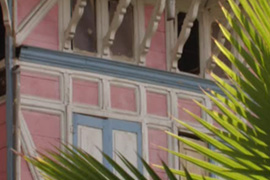Haiti’s heritage key to its future
Architects look to the country’s historic buildings as a model for its housing needs.

Between the mounds of rubble, steel girders and smashed concrete that still blanket entire neighbourhoods in Haiti’s capital you can catch glimpses of fairytale buildings from a bygone era.
They are known as Port-au-Prince’s ‘gingerbread’ houses – a term that refers to the fantastical nature of an architectural style that fused turn-of-the-century European influences with traditional Haitian design.
Keep reading
list of 4 itemsFacebook, Instagram face EU scrutiny over addictive effects on children
Who benefits from US tariffs on Chinese imports? Experts weigh in
Biden slaps new tariffs on Chinese imports, ratcheting trade war
Sugary pink with white-painted timber frames or honeycomb yellow with elaborate wooden fretwork, many of the houses date back to the 1800s and their steep pointed turrets, latticed iron clock towers and high ceilings have brought a touch of magic to Haiti’s urban landscape for many decades.
Still standing
 |
| Haiti’s ‘gingerbread’ houses fuse European influences with indigenous design |
The fact that many are still standing as they have for generations – relatively unscathed by the earthquake that devastated huge swathes of this city – means the historic ‘gingerbread’ houses are now being touted as a possible model for Haiti’s housing needs.
Patrice Milfort is a Haitian engineer who is refurbishing one of the larger ‘gingerbreads’ that has fallen into disrepair. He bought the house 18 months ago with the dream of turning it into a traditional restaurant, but when the earth shook on January 12, Patrice feared the worst.
“When I arrived here the only damage we found was that some of the bricks had shaken loose,” he says demonstrating how the wooden cross-supports sustained the building’s movement.
“It’s stood here for over 100 years so I guess we shouldn’t be surprised it survived intact.”
Golden age
The ‘gingerbreads’ recall a golden age when Port-au-Prince was a popular tourist destination – the name itself coined by American tourists in the 1950s.
“These houses remind you of the time when Haiti was beautiful and enjoyable,” Patrice says. “That was the best time of Haiti – when you see all those pictures of these types of houses with the streets nice and clean.”
But as the nation’s economy crumbled under the weight of dictatorship and flawed international aid policies, an increasingly desperate populace flocked into the capital looking for work.
Cheap housing was thrown up in the capital to accommodate the throngs of new residents, and the city’s population swelled to far beyond its capacity.
Look to the past
 |
| Their wooden frames helped the ‘gingerbread’ houses to resist the earthquake |
Haitian architects say the lack of building codes is what made the 7.2 magnitude earthquake so utterly devastating.
“To build this city back better, we need to look at the past,” says Olson Jean Julien, a former minister of culture who is trying to regenerate the ‘gingerbread’ districts and spearheading efforts to preserve the old houses.
Walking in the grounds of the majestic Oloffson hotel, the “jewel in the crown” as he describes it, Julien explains how the fretwork on some of the houses is thought to represent traditional vévé patterns used in the practice of voodoo.
But it is also the open-plan design of the houses, Julien explains, with their large porches and wide steps down to the street that make them part of traditional Haitian architectural heritage.
“They faced onto the street, with areas for people to sit and talk – that’s how our society works, and we need to remember all of these things when deciding how to rebuild.”